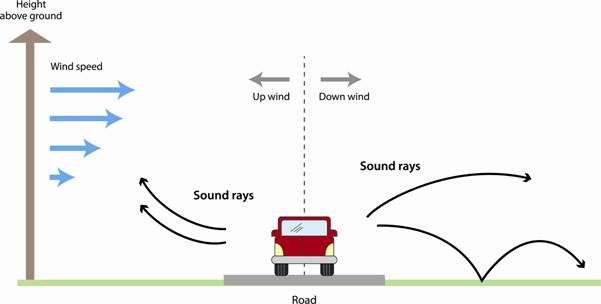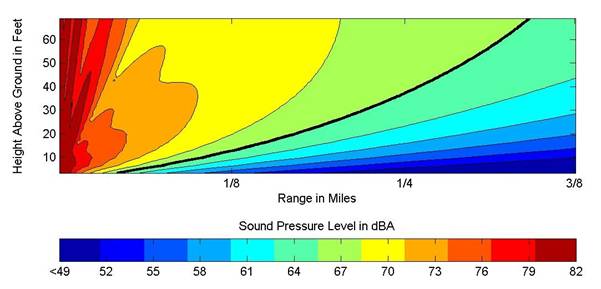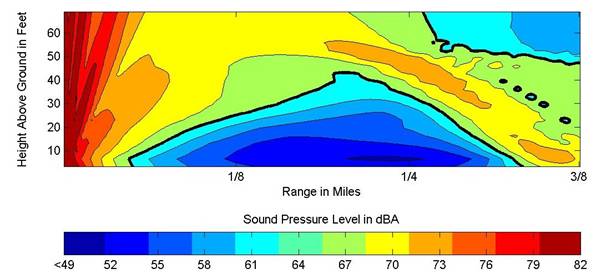
FIGURE 1: The thin arrows show the direction of noise propagation when the wind blows from left to right across the freeway. Image courtesy of Anne Aballe.
Nick Ovenden – nicko@math.ucl.ac.uk
Department of Mathematics,
University College London,
Gower St,
London WC1E 6BT
Stephen Shaffer – srshaffe@asu.edu
Center for Environmental Fluid Dynamics,
Department of Mechanical and Aerospace Engineering
Arizona State University,
Tempe, AZ 85287-9809
Harindra Fernando - Harindra.J.Fernando.10@nd.edu
Environmental Fluid Dynamics Group,
Department of Civil Engineering and Geological Sciences,
University of Notre Dame,
Notre Dame, IN 46556
Popular version of paper 2pNS3
Presented Tuesday Afternoon, May 24, 2011
161st ASA Meeting, Seattle, Wash.
How sound travels through the atmosphere
We have all experienced it – some days the normal everyday activities around us sound louder than usual. Sometimes you can hear people talking very clearly from the other side of a parking lot or traffic noise just sounds much louder at different times of day and on different days even though the traffic itself is quite similar. The fact is that this is often due to wind speed and direction, temperature, cloud cover and the position of the Sun. For instance, on a blustery day it is usually difficult to communicate orally with someone who is at some distance upwind from you, but a common misconception is that the wind somehow blows or carries the sound away from the listener. In fact, the science is far more subtle than that as sound traveling upwind or downwind behaves in a remarkably similar way to light passing through a prism; the mechanism in both cases is known as refraction. Hence sound that travels upwind actually tends to become bent (refracted) upward into the sky, missing its intended target. Conversely when the sound travels downwind it becomes bent toward the ground and can become trapped close to the ground as shown in figure 1. Changes in temperature induce a similar effect as sound bends away from hotter zones and toward cooler ones. So, in the middle of the day when the sun is shining, sound bends away from the hot ground and up vertically into the sky. At dawn and dusk however, when the ground is cooling, the air near the surface may also become cooler than the air at higher altitudes and, as a consequence, sound will become refracted downward and trapped close to the ground.

FIGURE 1: The thin arrows show the direction of noise propagation when the wind blows from left to right across the freeway. Image courtesy of Anne Aballe.
Noise pollution from freeway corridors
Noise pollution itself has increasingly become a serious environmental concern. Noise above a certain level diminishes the quality of life for local residents and also adversely affects wildlife. There are many sources of urban noise, including aircraft, heavy industry, and railways. But, a principal contributor to urban noise is undoubtedly freeway corridors. In Scottsdale, Ariz., a number of residents living more than a quarter mile from the East Loop 101 freeway have complained in the past about traffic noise levels, particularly during the early morning and early evening rush hours. Noise measurements subsequently made in response to their complaints potentially indicated that atmospheric conditions may explain the high noise levels experienced. In recent years, we have been working with the Arizona Department of Transportation to understand these noise issues. A particular concern of our research is that the Federal Highway Administration’s traffic noise models and policy do not take into account the influence of local atmospheric conditions. Urban planners may therefore be underestimating the noise exposure encountered by residents living some distance from the freeway.
Our research – experiments and simulation
Our research collaboration with ADOT so far has involved field measurements of freeway noise and local atmospheric conditions, as well as the development of mathematical models, which can obtain better predictions of the potential noise exposure. The field experiments started in October 2006 where measuring equipment was set up at two sites, one on the Phoenix loop of Highway 101 and one on the Phoenix loop of Highway 202. Both wind speed and temperature were measured vertically up to an altitude of approximately 1000 feet (300 meters). We also simultaneously recorded sound levels at the side of the freeway. We then developed a computer simulation to gain some idea of how the variations in wind and temperature measured early in the morning would alter the measured traffic noise as it travels downwind away from the freeway.

Figure 2: Noise level in A-weighted decibels (dBA) indicated by color contours plotted against horizontal distance from the Highway 202 freeway (in miles) and height from the ground (in feet) obtained from a computer model neglecting the local atmospheric conditions measured at the site.

Figure 3: Noise level in A-weighted decibels (dBA) indicated by color contours plotted against horizontal distance from the Highway 202 freeway (in miles) and height from the ground (in feet) obtained from a computer model but now including the influence the local atmospheric conditions measured at the site.
As an example of our model results, compare the two plots presented in figures 2 and 3, which both show a representative sound field obtained by our computer model using atmospheric and noise data recorded at the Highway loop 202 site at 8 a.m. during a particular field experiment. The calculation used to produce figure 2 ignores any atmospheric effects by assuming a constant temperature and no wind, whereas the actual wind and temperature information measured at the site is accounted for in the simulation result shown in figure 3. The contours drawn on each plot show the noise level using an A-weighted decibel (dBA) scale at distances from the freeway up to just over 3/8 of a mile and at heights from the ground up to approximately 65 feet. ABy ignoring wind and temperature changes you will notice that at human height (5-6 feet) the result in figure 2 predicts the noise level to fall continuously with distance away from the freeway dropping to a level well below 50 dBA beyond one-third of a mile; such a level is equivalent to the background noise in a room. Compare this to figure 3, which incorporates the refractive effects of the wind and temperature gradients measured at the site. By accounting for these atmospheric effects, the computer model predicts a rather interesting and surprising outcome. The traffic noise that initially heads upward away from the ground is eventually turned back toward the ground, focusing the noise over a small area located approximately 3/8 of a mile from the freeway (550-600 metres). In this focusing area the sound level predicted is around 70dBA, which is equivalent to the noise level experienced by standing near a vacuum cleaner or food mixer. Curiously enough in this example case, at an intermediate location half that distance from the freeway the noise is significantly quieter, at around 50-55dBA. This is a noise level roughly equivalent to the sound of rainfall or hearing a quiet conversation in an office!
Summary of our findings
The computer model clearly demonstrates the importance of accounting for local atmospheric conditions when making predictions of noise exposure near freeways in populated areas. The Federal Highway Administration’s noise abatement criterion is 67dBA, meaning that above this level of noise exposure action must be taken by authorities to reduce it. Our results suggest that it may be relatively common to find local atmospheric conditions where such levels can be exceeded in some residential areas at certain times of the day. To reduce noise exposure, one possible action that is often considered is the construction of a noise barrier next to the freeway. However, the fact that significant noise in the case shown is predicted to take a fairly steep path upward to a relatively high altitude of 50 feet, before being directed back toward the ground, suggests that a noise barrier of 8 feet in height would have had little effect on mitigating the high noise exposure predicted at 3/8 of a mile from the freeway.
Our research work continues in this socially important area, first by looking at terrain effects, including freeway canyons and noise barriers, and also by examining the similar concerns of residents living within a few miles of proposed wind farm sites.